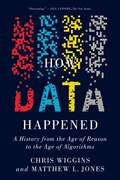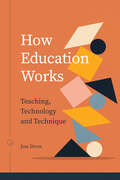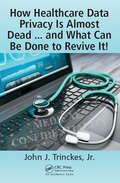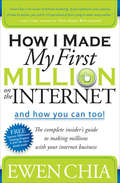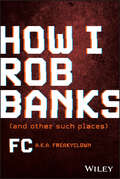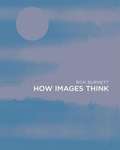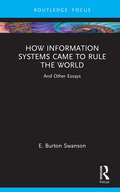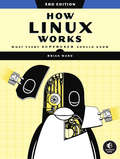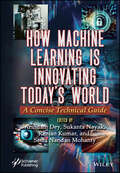- Table View
- List View
How Data Happened: A History from the Age of Reason to the Age of Algorithms
by Matthew L. Jones Chris Wiggins“Fascinating.” —Jill Lepore, The New Yorker A sweeping history of data and its technical, political, and ethical impact on our world. From facial recognition—capable of checking people into flights or identifying undocumented residents—to automated decision systems that inform who gets loans and who receives bail, each of us moves through a world determined by data-empowered algorithms. But these technologies didn’t just appear: they are part of a history that goes back centuries, from the census enshrined in the US Constitution to the birth of eugenics in Victorian Britain to the development of Google search. Expanding on the popular course they created at Columbia University, Chris Wiggins and Matthew L. Jones illuminate the ways in which data has long been used as a tool and a weapon in arguing for what is true, as well as a means of rearranging or defending power. They explore how data was created and curated, as well as how new mathematical and computational techniques developed to contend with that data serve to shape people, ideas, society, military operations, and economies. Although technology and mathematics are at its heart, the story of data ultimately concerns an unstable game among states, corporations, and people. How were new technical and scientific capabilities developed; who supported, advanced, or funded these capabilities or transitions; and how did they change who could do what, from what, and to whom? Wiggins and Jones focus on these questions as they trace data’s historical arc, and look to the future. By understanding the trajectory of data—where it has been and where it might yet go—Wiggins and Jones argue that we can understand how to bend it to ends that we collectively choose, with intentionality and purpose.
How Data Science Is Transforming Health Care
by Tim O'Reilly Mike Loukides Julie Steele Colin Hill<p>In the early days of the 20th century, department store magnate John\nWanamaker famously said, "I know that half of my advertising doesn't\nwork. The problem is that I don't know which half." That remained\nbasically true until Google transformed advertising with AdSense based\non new uses of data and analysis. The same might be said about health\ncare and it's poised to go through a similar transformation as new\ntools, techniques, and data sources come on line. Soon we'll make\npolicy and resource decisions based on much better understanding of\nwhat leads to the best outcomes, and we'll make medical decisions\nbased on a patient's specific biology. The result will be better\nhealth at less cost.<br/><br/>\nThis paper explores how data analysis will help us structure the\nbusiness of health care more effectively around outcomes, and how it\nwill transform the practice of medicine by personalizing for each\nspecific patient.</p>
How Digital Intelligence Drives Business Growth (Management for Professionals)
by Zhizhuan Business Research InstituteThis book aims to build a framework for understanding how to achieve new business growth through digital intelligence. It reveals the driving force and commercial logic behind the technology upgrade and transformation for enterprises, analyzes how to improve enterprises' branding, product, distribution channel, marketing, logistics, and organization under the new context, and studies the successful cases in digital intelligence of 6 Chinese enterprises. For business school students, researchers, managers, and practitioners, it is helpful to build an overview and understanding on strategy level as well as practice level.
How Do I Photograph A Sunset?: More than 150 essential photography questions answered
by Chris GatcumHow do we learn? We learn by asking questions. But what if we don't know what questions we should be asking? Thanks to the digital revolution, photography has never been so popular, and whether you shoot on a phone or a top-spec DSLR or CSC camera, the urge to improve is relentless. In this book, author Chris Gatcum asks the questions that every photographer will have in mind at some point in their image-making journey, and then answers them in a clear, concise, straightforward and inspirational manner. Laid out in intuitive sections, this book tackles the questions that are on every photographer's mind, as well as those that they haven't thought of yet. And with a clear progression through each chapter, from the simple to more complex, the book asks - and answers - questions to satisfy the complete novice as well as the advanced practitioner.
How Do I Photograph A Sunset?: More than 150 essential photography questions answered
by Chris GatcumHow do we learn? We learn by asking questions. But what if we don't know what questions we should be asking? Thanks to the digital revolution, photography has never been so popular, and whether you shoot on a phone or a top-spec DSLR or CSC camera, the urge to improve is relentless. In this book, author Chris Gatcum asks the questions that every photographer will have in mind at some point in their image-making journey, and then answers them in a clear, concise, straightforward and inspirational manner. Laid out in intuitive sections, this book tackles the questions that are on every photographer's mind, as well as those that they haven't thought of yet. And with a clear progression through each chapter, from the simple to more complex, the book asks - and answers - questions to satisfy the complete novice as well as the advanced practitioner.
How Does It Sound Now?: Legendary Engineers and Vintage Gear
by Gary GottliebHow Does It Sound Now? features 32 interviews with top engineers and producers who have contributed to hundreds of millions of albums and CDs throughout their combined careers, including a new interview with Leslie Gaston-Bird for this second edition.Winner of the 2010 Association for Recorded Sound Collections' Award for Excellence in Historical Recorded Sound Research, the second edition of How Does It Sound Now? allows readers to benefit from the collective experience of 32 industry heavyweights, whose interviews provide a comprehensive overview of the changes in methodology and equipment over the last 60 years. The collection focuses on engineers who made the transition through different technologies—analog to digital, wire to tape, and CD to mp3—and explores the methodology they employed when confronted with new and evolving technology. With a wide range of interviewees, from Phil Ramone to Geoff Emerick, discussions are centered around how producers and engineers retain quality and continue to create a product that conforms to their own high standards in the face of changing technologies.The techniques described will be valuable to students of audio history or theory and recording courses, and will also be of interest to audio professionals, including home recordists and studio owners, who can use this book to educate their staff and offer to clients.
How Education Works: Teaching, Technology, and Technique (Issues in Distance Education)
by Jon DronIn this engaging volume, Jon Dron views education, learning, and teaching through a technological lens that focuses on the parts we play in technologies, from language and pedagogies to computers and regulations. He proposes a new theory of education whereby individuals are not just users but co-participants in technologies— technologies that are intrinsic parts of our cognition, of which we form intrinsic parts, through which we are entangled with one another and the world around us. Dron reframes popular families of educational theory (objectivist, subjectivist, and complexivist) and explains a variety of educational phenomena, including the failure of learning style theories, the nature of literacies, systemic weaknesses in learning management systems, the prevalence of cheating in educational institutions, and the fundamental differences between online and in-person learning. Ultimately, How Education Works articulates how practitioners in education can usefully understand technology, education, and their relationship to improve teaching practice.
How Executives Should Think About AI: Straight Talk About the Inevitable
by Stephen J. AndrioleMuch of what is said about AI is misleading – or just plain wrong. It’s also sometimes intended to frighten everyone about a future that’s unlikely to occur (think Bill Gates, Elon Musk, Steve Wozniak and Geoffrey Hinton, among others). AI will not steal children, hold hostages for bitcoins or start nuclear wars. But it will fundamentally change business through the intelligent automation of many routine – and nonroutine – tasks that companies perform all the time. Old business models will die as fast as new ones emerge. Whole industries will be reengineered, reinvented and reimagined. Some will be displaced altogether. Some industries will be disrupted in every sense of the word – in just three-to-five years. In fact, it’s already begun.How Executives Should Think About AI: Straight Talk About the Inevitable prepares executives for the AI future. It’s not a complicated treatise on AI, or a theoretical look at how new technology can transform business models and processes. It’s a series of conversations masquerading as chapters designed to help executives quickly understand AI, what it can do and what they should do about AI, machine learning (ML) and generative AI (GenAI) right now. These conversations about AI are intended to get executives up to speed on AI, ML and GenAI so that they become “AI comfortable” in many ways, including launching a steady stream of demonstration prototypes to help their companies explore AI's capabilities and potential benefits.These timely conversations can help executives understand how AI will impact their companies and their professional success. It’s straight talk about the most important technology since the Internet. Executives have no choice but to embrace AI to accomplish their professional goals. This book helps accomplish these goals. It helps them make decisions about what AI can and cannot do for their companies.
How Fuzzy Concepts Contribute to Machine Learning (Studies in Fuzziness and Soft Computing #416)
by Vicenç Torra Mahdi Eftekhari Adel Mehrpooya Farid Saberi-MovahedThis book introduces some contemporary approaches on the application of fuzzy and hesitant fuzzy sets in machine learning tasks such as classification, clustering and dimension reduction. Many situations arise in machine learning algorithms in which applying methods for uncertainty modeling and multi-criteria decision making can lead to a better understanding of algorithms behavior as well as achieving good performances. Specifically, the present book is a collection of novel viewpoints on how fuzzy and hesitant fuzzy concepts can be applied to data uncertainty modeling as well as being used to solve multi-criteria decision making challenges raised in machine learning problems. Using the multi-criteria decision making framework, the book shows how different algorithms, rather than human experts, are employed to determine membership degrees. The book is expected to bring closer the communities of pure mathematicians of fuzzy sets and data scientists.
How Happy to Call Oneself a Turk
by Gavin D. BrockettThe modern nation-state of Turkey was established in 1923, but when and how did its citizens begin to identify themselves as Turks? Mustafa Kemal Ataturk, Turkey's founding president, is almost universally credited with creating a Turkish national identity through his revolutionary program to "secularize" the former heartland of the Ottoman Empire. Yet, despite Turkey's status as the lone secular state in the Muslim Middle East, religion remains a powerful force in Turkish society, and the country today is governed by a democratically elected political party with a distinctly religious (Islamist) orientation. In this history, Gavin D. Brockett takes a fresh look at the formation of Turkish national identity, focusing on the relationship between Islam and nationalism and the process through which a "religious national identity" emerged. Challenging the orthodoxy that Ataturk and the political elite imposed a sense of national identity from the top down, Brockett examines the social and political debates in provincial newspapers from around the country. He shows that the unprecedented expansion of print media in Turkey between 1945 and 1954, which followed the end of strict, single-party authoritarian government, created a forum in which ordinary people could inject popular religious identities into the new Turkish nationalism. Brockett makes a convincing case that it was this fruitful negotiation between secular nationalism and Islam--rather than the imposition of secularism alone--that created the modern Turkish national identity.
How Healthcare Data Privacy Is Almost Dead ... and What Can Be Done to Revive It!
by John J. Trinckes, Jr.The healthcare industry is under privacy attack. The book discusses the issues from the healthcare organization and individual perspectives. Someone hacking into a medical device and changing it is life-threatening. Personal information is available on the black market. And there are increased medical costs, erroneous medical record data that could lead to wrong diagnoses, insurance companies or the government data-mining healthcare information to formulate a medical ‘FICO’ score that could lead to increased insurance costs or restrictions of insurance. Experts discuss these issues and provide solutions and recommendations so that we can change course before a Healthcare Armageddon occurs.
How Humans Judge Machines
by Cesar A. Hidalgo Diana Orghiain Jordi Albo Canals Filipa De Almeida Natalia MartinHow people judge humans and machines differently, in scenarios involving natural disasters, labor displacement, policing, privacy, algorithmic bias, and more.How would you feel about losing your job to a machine? How about a tsunami alert system that fails? Would you react differently to acts of discrimination depending on whether they were carried out by a machine or by a human? What about public surveillance? How Humans Judge Machines compares people's reactions to actions performed by humans and machines. Using data collected in dozens of experiments, this book reveals the biases that permeate human-machine interactions. Are there conditions in which we judge machines unfairly? Is our judgment of machines affected by the moral dimensions of a scenario? Is our judgment of machine correlated with demographic factors such as education or gender? César Hidalgo and colleagues use hard science to take on these pressing technological questions. Using randomized experiments, they create revealing counterfactuals and build statistical models to explain how people judge artificial intelligence and whether they do it fairly. Through original research, How Humans Judge Machines bring us one step closer tounderstanding the ethical consequences of AI.
How I Discovered World War II's Greatest Spy and Other Stories of Intelligence and Code: And Other Stories Of Intelligence And Codes
by David KahnThis book recounts the desperate efforts to gather information during World War II and the Cold War. The author provides insight into the dark realm of intelligence and code that will fascinate cryptographers, intelligence personnel, and the millions of people interested in military history, espionage adventure, and world affairs. David Kahn is universally regarded as the dean of intelligence historians. Authoritative and addictively readable, this book, by revealing the past, helps guide present and future intelligence efforts.
How I Made My First Million on the Internet and How You Can Too!: The Complete Insider's Guide to Making Millions with Your Internet Business
by Ewen ChiaA comprehensive step-by-step guide to setting up a booming Internet business! Successful entrepreneur Ewen Chia demystifies marketing jargon and shares the tips and techniques that continue to net his online businesses a cool fortune. Whether you&’re seeking to create and develop a thriving Internet business from scratch or looking to realize the full potential of your existing business, whether you haven&’t a clue what the Internet is about or you&’re armed with a business degree, Ewen&’s upbeat and accessibly written Million-Dollar Blueprint will help you: * Find out who&’s buying what and develop lucrative solutions to meet market needs * Grab and keep the attention of prospective buyers with irresistible offers * Create a follow-up system of additional offers to boost income and grow your business * Automate your business so you can enjoy the ultimate rewards of profits, time, and leisure * Duplicate your business(es) to multiply your total income
How I Rob Banks: And Other Such Places
by FCFollow FC as he steals from the world’s most secure banks and government facilities—without breaking a single law In How I Rob Banks: And Other Such Places, renowned ethical hacker and social engineer FC delivers a gripping and often hilarious discussion of his work: testing the limits of physical bank security by trying to “steal” money, data, and anything else he can get his hands on. In the book, you’ll explore the secretive world of physical assessments and follow FC as he breaks into banks and secure government locations to identify security flaws and loopholes. The author explains how banks and other secure facilities operate, both digitally and physically, and shows you the tools and techniques he uses to gain access to some of the world’s most locked-down buildings. You’ll also find: Strategies you can implement immediately to better secure your own company, home, and data against malicious actors Detailed photos, maps, and drawings to bring to life the unbelievable true stories contained inside An inside and candid look at a rarely examined industry through the eyes of one of its most respected penetration testers A can’t-miss account of real-life security exploits perfect for infosec pros, including red and blue teamers, pentesters, CIOs, CISSPs, and social engineers, How I Rob Banks also belongs in the hands of anyone who loves a great Ocean’s 11-style story pulled straight from the real world.
How Images Think
by Ron BurnettDigital images are an integral part of all media, including television, film, photography, animation, video games, data visualization, and the Internet. In the digital world, spectators become navigators wending their way through a variety of interactive experiences, and images become spaces of visualization with more and more intelligence programmed into the very fabric of communication processes. In How Images Think, Ron Burnett explores this new ecology, which has transformed the relationships humans have with the image-based technologies they have created. So much intelligence has been programmed into these image-dependent technologies that it often seems as if images are "thinking"; ascribing thought to machines redefines our relationship with them and enlarges our ideas about body and mind. Burnett argues that the development of this new, closely interdependent relationship marks a turning point in our understanding of the connections between humans and machines. After presenting an overview of visual perception, Burnett examines the interactive modes of new technologies -- including computer games, virtual reality, digital photography, and film -- and locates digital images in a historical context. He argues that virtual images occupy a "middle space," combining the virtual and the real into an environment of visualization that blurs the distinctions between subject and object -- part of a continuum of experiences generated by creative choices by viewers, the results of which cannot be attributed either to images or to participants.
How Information Systems Came to Rule the World: And Other Essays (Routledge Focus on IT & Society)
by Burt SwansonThis book offers a fresh perspective on information systems, a field of study and practice currently undergoing substantial upheaval, even as it expands rapidly and widely with new technologies and applications. Mapping the field as it has developed, the author firmly establishes the under-recognized importance of the field, and grounds it firmly in the subject’s history. He argues against the view of enthusiasts who believe that the field has somehow moved "beyond information systems" to something more exotic and offers a short and compelling manifesto on behalf of the field and its future. Offering a comprehensive insight into the significance of the information systems field, this book will appeal primarily to scholars and practitioners working in information systems, management, communication studies, technology studies, and related areas.
How Intranets Work
by Preston GrallaNow you can learn how intranets work, what they can and cannot do for your organization. This is a great beginner's guide to intranets.
How JavaScript Works: Master the Basics of JavaScript and Modern Web App Development
by Jonathon SimpsonJavaScript is a complicated language with a lot of misinformation surrounding how it works. This book provides a comprehensive introduction to JavaScript, from how it works at a technical level to how it is used to create websites and applications. Everything you need to know to start a career in JavaScript development is covered here. How JavaScript Works begins with a practical introduction of the basics before moving into the technical underpinnings of JavaScript, detailing everything you need to know, including variables, memory storage, functions, classes, types, maps, sets and APIs. Once you’ve fully absorbed these key topics. author Jonathan Simpson will show you how to put them into practice, demonstrating how they are employed for modern web development. You’ll learn how to use JavaScript with HTML and CSS to construct web pages and applications, how to change CSS with JavaScript, and how to utilize Fetch and asynchronous operations. Upon completing this book, you will have the foundational knowledge necessary to continue your journey to becoming a professional JavaScript developer. What You Will Learn: Gain insight into the technical essentials of JavaScript and how it worksLearn advanced concepts and such as memory storage and how classes, functions and objects actually workExplore the basic mathematical underpinnings of JavaScriptUnderstand how JavaScript is used to manipulate HTML and CSSObtain the tools and knowledge needed to start your career in web development Who This Book Is For: Anyone interested in a web development career, as well as those who may have already embarked on their careers, but who want to deepen their technical understanding of JavaScript and how it works.
How Large Language Models Work
by Drew Farris Edward Raff Stella BidermanLearn how large language models like GPT and Gemini work under the hood in plain English.How Large Language Models Work translates years of expert research on Large Language Models into a readable, focused introduction to working with these amazing systems. It explains clearly how LLMs function, introduces the optimization techniques to fine-tune them, and shows how to create pipelines and processes to ensure your AI applications are efficient and error-free. In How Large Language Models Work you will learn how to: • Test and evaluate LLMs • Use human feedback, supervised fine-tuning, and Retrieval Augmented Generation (RAG) • Reducing the risk of bad outputs, high-stakes errors, and automation bias • Human-computer interaction systems • Combine LLMs with traditional ML How Large Language Models Work is authored by top machine learning researchers at Booz Allen Hamilton, including researcher Stella Biderman, Director of AI/ML Research Drew Farris, and Director of Emerging AI Edward Raff. They lay out how LLM and GPT technology works in plain language that&’s accessible and engaging for all. About the Technology Large Language Models put the &“I&” in &“AI.&” By connecting words, concepts, and patterns from billions of documents, LLMs are able to generate the human-like responses we&’ve come to expect from tools like ChatGPT, Claude, and Deep-Seek. In this informative and entertaining book, the world&’s best machine learning researchers from Booz Allen Hamilton explore foundational concepts of LLMs, their opportunities and limitations, and the best practices for incorporating AI into your organizations and applications. About the Book How Large Language Models Work takes you inside an LLM, showing step-by-step how a natural language prompt becomes a clear, readable text completion. Written in plain language, you&’ll learn how LLMs are created, why they make errors, and how you can design reliable AI solutions. Along the way, you&’ll learn how LLMs &“think,&” how to design LLM-powered applications like agents and Q&A systems, and how to navigate the ethical, legal, and security issues. What&’s Inside • Customize LLMs for specific applications • Reduce the risk of bad outputs and bias • Dispel myths about LLMs • Go beyond language processing About the Readers No knowledge of ML or AI systems is required. About the Author Edward Raff, Drew Farris and Stella Biderman are the Director of Emerging AI, Director of AI/ML Research, and machine learning researcher at Booz Allen Hamilton. Table of Contents 1 Big picture: What are LLMs? 2 Tokenizers: How large language models see the world 3 Transformers: How inputs become outputs 4 How LLMs learn 5 How do we constrain the behavior of LLMs? 6 Beyond natural language processing 7 Misconceptions, limits, and eminent abilities of LLMs 8 Designing solutions with large language models 9 Ethics of building and using LLMs
How Linux Works, 2nd Edition: What Every Superuser Should Know
by Brian WardUnlike some operating systems, Linux doesn’t try to hide the important bits from you—it gives you full control of your computer. But to truly master Linux, you need to understand its internals, like how the system boots, how networking works, and what the kernel actually does.In this completely revised second edition of the perennial best seller How Linux Works, author Brian Ward makes the concepts behind Linux internals accessible to anyone curious about the inner workings of the operating system. Inside, you’ll find the kind of knowledge that normally comes from years of experience doing things the hard way. You’ll learn:–How Linux boots, from boot loaders to init implementations (systemd, Upstart, and System V)–How the kernel manages devices, device drivers, and processes–How networking, interfaces, firewalls, and servers work–How development tools work and relate to shared libraries–How to write effective shell scriptsYou’ll also explore the kernel and examine key system tasks inside user space, including system calls, input and output, and filesystems. With its combination of background, theory, real-world examples, and patient explanations, How Linux Works will teach you what you need to know to solve pesky problems and take control of your operating system.
How Linux Works, 3rd Edition: What Every Superuser Should Know
by Brian WardBest-selling guide to the inner workings of the Linux operating system with over 50,000 copies sold since its original release in 2014. Unlike some operating systems, Linux doesn&’t try to hide the important bits from you—it gives you full control of your computer. But to truly master Linux, you need to understand its internals, like how the system boots, how networking works, and what the kernel actually does. In this third edition of the bestselling How Linux Works, author Brian Ward peels back the layers of this well-loved operating system to make Linux internals accessible. This edition has been thoroughly updated and expanded with added coverage of Logical Volume Manager (LVM), virtualization, and containers. You'll learn: • How Linux boots, from boot loaders to init (systemd) • How the kernel manages devices, device drivers, and processes • How networking, interfaces, firewalls, and servers work • How development tools work and relate to shared libraries • How to write effective shell scripts You&’ll also explore the kernel and examine key system tasks inside user space, including system calls, input and output, and filesystems. With its combination of background, theory, real-world examples, and patient explanations, How Linux Works, 3rd edition will teach you what you need to know to solve pesky problems and take control of your operating system.
How Linux Works: What Every Superuser Should Know
by Brian WardWhether you're a systems administrator or a home user, you need to understand how Linux internals work before you can really master Linux — how it boots, how networking works, how to customize the kernel, and even what hardware to buy.How Linux Works contains the kind of information normally handed down from wizards—knowledge that comes from years of experience doing things the hard way. But instead of seeking the right incantation to make your system work, you can read How Linux Works to see how to administer Linux and why each particular technique works.This book covers such need-to-know topics as:–How Linux boots, with coverage of boot loaders and init–How networking, interfaces, firewalls, and servers work–How development tools and shared libraries work–How the kernel manages devices, device drivers, and processes, and how to build a custom kernel–How the Linux printing system works, with sections on cups, filters, and Ghostscript–How shell scripts workWith its combination of background theory and real-world examples, How Linux Works will show you how to run your system instead of having your system run you.
How Machine Learning is Innovating Today's World: A Concise Technical Guide
by Arindam Dey Sukanta Nayak Sachi Nandan Mohanty Ranjan KumarProvides a comprehensive understanding of the latest advancements and practical applications of machine learning techniques. Machine learning (ML), a branch of artificial intelligence, has gained tremendous momentum in recent years, revolutionizing the way we analyze data, make predictions, and solve complex problems. As researchers and practitioners in the field, the editors of this book recognize the importance of disseminating knowledge and fostering collaboration to further advance this dynamic discipline. How Machine Learning is Innovating Today's World is a timely book and presents a diverse collection of 25 chapters that delve into the remarkable ways that ML is transforming various fields and industries. It provides a comprehensive understanding of the practical applications of ML techniques. The wide range of topics include: An analysis of various tokenization techniques and the sequence-to-sequence model in natural language processing explores the evaluation of English language readability using ML models a detailed study of text analysis for information retrieval through natural language processing the application of reinforcement learning approaches to supply chain management the performance analysis of converting algorithms to source code using natural language processing in Java presents an alternate approach to solving differential equations utilizing artificial neural networks with optimization techniques a comparative study of different techniques of text-to-SQL query conversion the classification of livestock diseases using ML algorithms ML in image enhancement techniques the efficient leader selection for inter-cluster flying ad-hoc networks a comprehensive survey of applications powered by GPT-3 and DALL-E recommender systems' domain of application reviews mood detection, emoji generation, and classification using tokenization and CNN variations of the exam scheduling problem using graph coloring the intersection of software engineering and machine learning applications explores ML strategies for indeterminate information systems in complex bipolar neutrosophic environments ML applications in healthcare, in battery management systems, and the rise of AI-generated news videos how to enhance resource management in precision farming through AI-based irrigation optimization. Audience The book will be extremely useful to professionals, post-graduate research scholars, policymakers, corporate managers, and anyone with technical interests looking to understand how machine learning and artificial intelligence can benefit their work.
How NOT to Lead: Lessons Every Manager Can Learn from Dumpster Chickens, Mushroom Farmers, and Other Office Offenders
by Chase CunninghamStep Aside, Mediocre Leaders: Learn What NOT To Do! Ditch the fluff and sugarcoating and learn how to lead the way your people deserve. In How NOT To Lead, Dr. Chase Cunningham, a seasoned cybersecurity heavyweight and Retired Navy Chief, doesn't give you a textbook guide on leadership — he delivers a no-holds-barred, gloves-off masterclass on the lethal mistakes that'll tank your leadership game and ultimately sink your reputation and even your company's future. Want the brutal truth? This book slaps you with some cold, hard realities: What happens when you fall off your ego and hit your IQ on the way down as a leader, and why you need to do that. The absolute idiocy of "Mushroom Farming": keeping your team in the dark, feeding them crap, and expecting gourmet results. A nowhere-to-hide deep dive into "Dumpster Chickens" leadership: using destructive tactics that rip apart team spirit and obliterate business success. The triple threat: the three non-negotiable currencies every leader MUST have. Miss one, and you're doomed. Eye-opening case studies — ripped from headlines and history books — that throw a spotlight on the real-world disasters of crappy leadership. Aimed squarely at managers, executives, and anyone brave enough to lead, How NOT To Lead is your audacious guide through the minefield of leadership pitfalls. If you've got the intestinal fortitude to read this book, then drop what you are doing and hitch up your britches for some tough love. Don't let mediocrity be your legacy, do better. Your employees deserve it and so do you!
